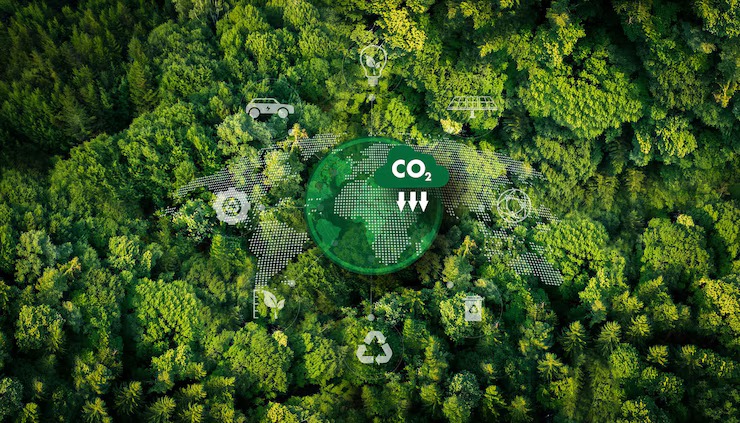
Understanding Net Zero
Imagine a balance sheet for carbon emissions. Net zero means a company, country, or individual emits no more greenhouse gases than they remove from the atmosphere. Emissions still happen, but they’re offset, like planting trees, using carbon capture tech, or switching to green energy.
Think of it as breaking even in a climate bank account.
A Copernicus Climate Change Service report verified that 2024 is the first year to exceed more than 1.5°C over the pre-industrial value. All of the last 10 years (2015-2024) were amongst the top 10 warmest years on record.
Net Zero is more than a climate buzzword; it is a science-based objective in line with keeping global warming to 1.5°C.
Unlike carbon neutrality, which often includes offsetting, net zero requires reducing emissions as close to zero as possible. The primary emission contributors are energy production, transportation, industry, and agriculture. Achieving net zero is not just an environmental imperative but an economic and ethical one.
To begin understanding climate goals, let’s break down four commonly used but often confused terms.
1. Carbon Neutral
This one’s similar to net zero, but it often refers more to offsetting emissions rather than eliminating them. If a company emits 100 tons of carbon, it can ‘neutralize’ that by investing in renewable projects or reforestation.
It’s like balancing your carbon guilt with good deeds.
2. Carbon Positive / Climate Positive
Oddly, being positive here doesn’t mean good.
- Carbon positive often means emitting more carbon than is being removed, either unintentionally or by flawed systems.
- Climate positive, on the other hand, is a newer term that means going beyond net zero, not just neutralizing impact, but creating environmental benefits.
So climate positive is the hero cape, while carbon positive is the villain in disguise.
3. Carbon Negative
This is when more carbon is being removed from the atmosphere than is emitted. It’s beyond neutrality, it’s actively cleaning up. Some companies and technologies aim for this by absorbing more CO₂ than they release.
Think of it like having a climate surplus instead of a debt.
4. Decarbonization
This is the process of cutting carbon emissions at the source, through clean energy, electric transport, sustainable industry practices, and more. It’s the long-term game plan to stop the problem before it even starts.
If carbon emissions were a tap, decarbonization is turning that tap off, slowly but surely.
Why Does This Matters?
These aren’t just buzzwords, they’re roadmaps. Governments, corporations, and even individuals are using these goals to shape our future. Understanding the difference helps us know where we stand, and what we need to push for.
Carbon Trading in India
India, boasting relatively low per‑capita carbon emissions but rapidly growing, has set its sights on achieving net‑zero emissions by 2070, a target first announced by Prime Minister Modi at COP26 in November 2021 and later formalized through a Long-Term Low‑Carbon Development Strategy (LT‑LEDS).
Let’s talk about one of India’s most ambitious climate tools, carbon trading. Think of it as putting a price on pollution while rewarding cleaner practices.
Carbon Trading, and Why Now?
India is the fourth largest emitter of greenhouse gases globally. At the same time, it’s a fast-growing economy trying to balance development goals with climate responsibility. That’s where carbon trading comes in.
So, if a factory cuts its emissions below a set limit, it earns carbon credits. Another company that’s still figuring out its green strategy can buy those credits to stay compliant. It’s like rewarding efficiency while nudging laggards to catch up.
India’s Own Carbon Trading System
India is developing a Carbon Credit Trading Scheme (CCTS) and it’s set to be a game-changer.
- What’s New?
This is not just a voluntary scheme for companies wanting to look green. It’s being developed as a national, compliance based carbon market, meaning it could become mandatory for certain sectors to offset or reduce emissions. - Who’s in Charge?
The Bureau of Energy Efficiency (BEE) and the Ministry of Power are steering the ship. - Why Does It Matters?
India is one of the first developing nations to build a unified carbon market, one that can track, regulate, and scale emissions across industries. This can help cut emissions cost-effectively while pushing companies toward innovation.
How Does It Work?
The market will have
- Buyers: Companies that emit more than allowed and need to purchase credits.
- Sellers: Those who reduce their emissions and generate extra credits to sell.
- Traders & Exchanges: Platforms where these credits are bought and sold, just like stocks or commodities.
This structure encourages continuous improvement, because the cleaner you get, the more value you unlock.
What Are the Benefits?
- Cost Efficiency: It’s cheaper for some companies to buy credits than to retrofit their entire systems at least in the short run.
- Green Innovation: Creates a real incentive to invest in clean tech, renewables, and energy efficiency.
- Global Trade Readiness: A domestic carbon market helps Indian businesses stay competitive in the global market, especially as carbon taxes and border adjustments become more common in the EU and beyond.
Challenges Ahead
Of course, it’s not all smooth sailing.
- Measurement & Verification: Tracking emissions accurately across sectors is tricky and essential.
- Sector Readiness: Not all industries are equally prepared to participate in carbon markets.
- Fair Pricing: Ensuring the price of carbon reflects real environmental costs without harming small players is a delicate balance.
What’s Next?
India is gradually transitioning from its existing energy-efficiency schemes like Perform, Achieve and Trade (PAT) and Renewable Energy Certificates, to a more robust carbon credit framework that can operate across sectors and possibly integrate with global markets down the line.
This carbon market isn’t just a policy, it’s a signal. India is ready to embed climate action into its economic engine, creating not just fewer emissions, but new business models, investment flows, and jobs.
Source
- Copernicus: 2024 is the first year to exceed 1.5°C above pre-industrial level
- Net zero targets | Climate Action Tracker
- Climate TRACE Releases February 2025 Emissions Data
- India’s Carbon Market Revolution: Balancing Economic Growth with Climate Responsibility
- India is committed to achieve the Net Zero emissions target by 2070 as announced by PM Modi, says Dr. Jitendra Singh


